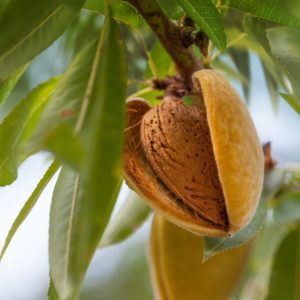Putting the pressure back on navel orangeworm
{Sponsored} Even when populations are trending down, navel orangeworm (NOW) is still the single biggest threat to almond orchard. It’s important for growers to utilize strong integrated pest management (IPM) strategies combined with a carefully planned insecticide regimen to control NOW.
Uncontrolled, a single female NOW can produce at least 150 eggs. It’s important growers use strategies that not only protect against larvae but also control NOW at all life stages. After all, a couple of moths can produce an infestation within a short amount of time. An infestation can cause a loss of 30 to 40% of an orchard’s yield and create quality issues that reduce the price a grower can fetch for their almond crop. “This is the type of insect that can explode on you … Growers really have to have a very regular control program. If you’re trying to chase after this insect after it’s grown up, it is a losing game,”said Joel Siegel, research entomologist with USDA-ARS.
Sanitation
The first line of defense in any NOW management plan is proper sanitation. Cleaning up any nuts that have fallen to the ground and shaking out any remaining at the end of the season will prevent NOW from taking hold in the off-season. Or at least significantly reduce the potential for an infestation during the growing season. Grinding or burning the nuts will destroy any eggs overwintering and eliminate their food source in the spring. Beyond this step, control is all about a strong insecticide plan.
Planning your sprays
Siegel recommends several steps for protecting almonds from NOW. First, it’s important growers use multiple sprays and time them properly to ensure all nuts are protected; even if they open at different rates. Almonds are at a higher risk as the hull opens more and more during ripening. It is important that sprays are timed and layered to prevent damage from NOW.
Spraying Altacor® insect control at the start of hull split and again 10-15 days later will give almonds better protection. The layers of coverage ensure that all surfaces of the almond trees will be protected, but the second spray will target the newly exposed nut tissue to stop NOW from destroying it. Siegel suggests using the maximum rate for both sprays of Altacor insect control. If additional coverage is needed, Siegel recommends using a different active ingredient late in the season.
Issa Qandah, technical services manager for FMC, advises taking the minutiae of spray timing a step further. “Managing NOW relies on a degree day model and crop physiology. There is no specific time to go and apply an insecticide. Growers have to be proactive. PCAs need to be proactive by walking the orchard and assessing the situation, because once the hull starts to split, the nuts are vulnerable,” Qandah said.
The first application should be in the spring, with growers spraying between April 21 and May 10, but is dependent on the degree of infestation. With the degree  day models factored in, the first generation of NOW will develop with a nearly 1,000 to 1,100 degree day. The application should be targeted to line up with that first 1,000 to 1,100 degree day.
day models factored in, the first generation of NOW will develop with a nearly 1,000 to 1,100 degree day. The application should be targeted to line up with that first 1,000 to 1,100 degree day.
The next application should align with the second generation, which requires only a 700 degree day — usually it’s in early July. This application will be most effective if it is applied when the moths are most active, between 2 a.m. to 5 a.m. A follow-up application should be deployed 10 to 14 days later with the same active ingredient after hulls split a few more millimeters to target the remainder of the second generation.
How Altacor insect control works
Altacor insect control affects NOW in all life stages. When a larvae chews through the egg wall, it ingests Altacor insect control and becomes paralyzed, quickly dying. Larvae that are sprayed after being hatched will be killed via contact with the spray. Adults are paralyzed and die within two days. It’s important to note that NOW will stop feeding seven minutes after contact with Altacor insect control. “Altacor insect contol is an excellent insecticide because it affects all life stages of NOW. It’s very stable in the field and has shown in my experiments to last 28 days,” Siegel said. With at least 28 days of residual activity, Altacor insect control protect almond tress long after the final application.
For more information about Altacor insect control, visit Altacor.ag.FMC.com.
Always read and follow all label directions, precautions and restrictions for use. Some products may not be registered for sale or use in all states. FMC, the FMC logo and Altacor are trademarks of FMC Corporation or an affiliate. ©2021 FMC Corporation. All rights reserved.









